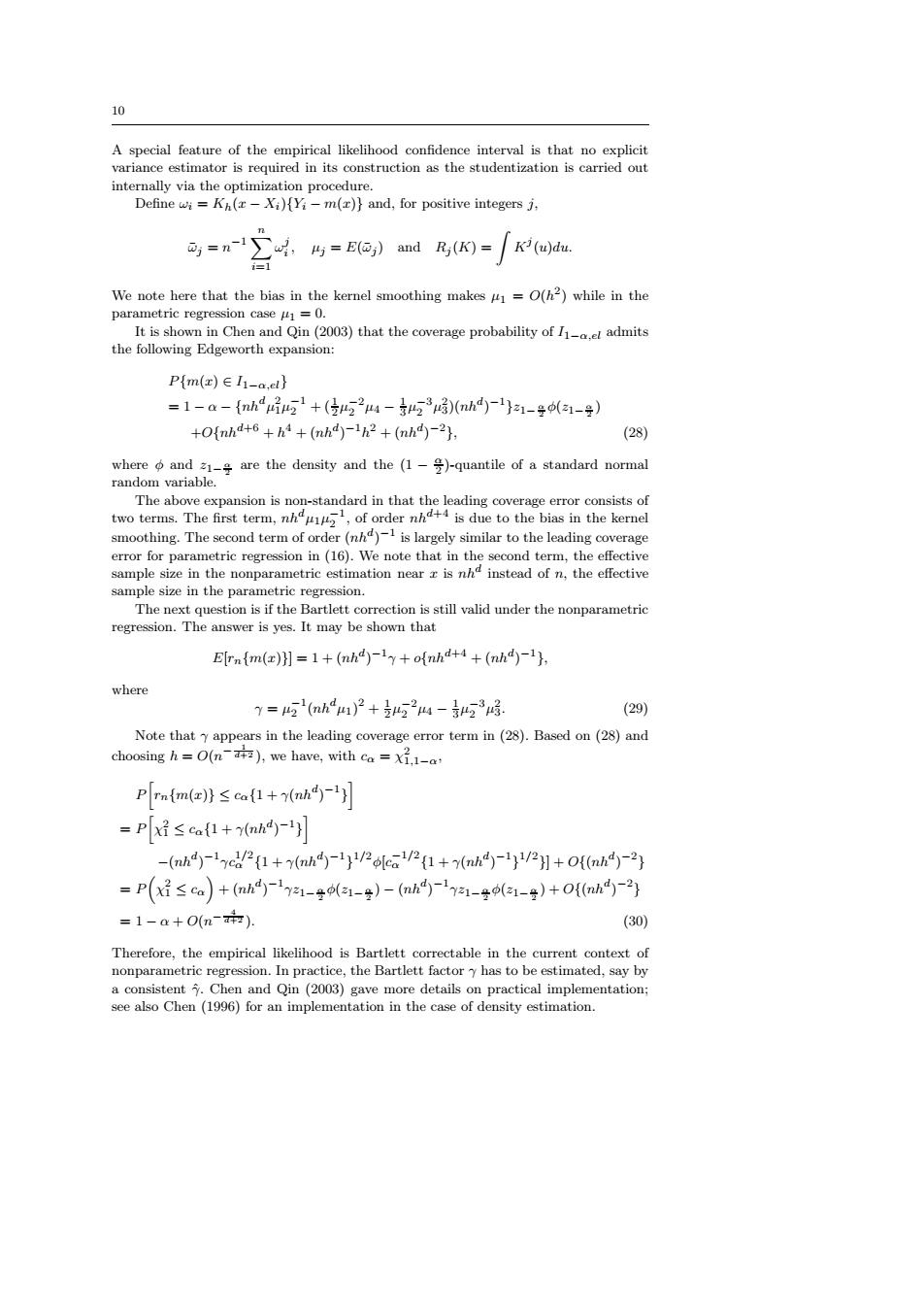正在加载图片...

o A special feature of the empirical likelihood confidence interval is that no explicit variance estimator is required in its construction as the studentization is carried out internally via the optimization procedure. Define wi=Kh(r-Xi){Yi-m(r)}and,for positive integers j, K(u)du We note here that the bias in the kernel smoothing makes u=O(h2)while in the parametric regression caseu=0. It is shown in Chen and Qin(2003)that the coverage probability of I1et admits the following Edgeworth expansion: P{m(x)∈Ii-a,el} =1-a-{nhi+(524-33)(nh)-1}a1-子(a-) +Onh+6+h4+(mh)-1h2+(h4-2, (28) where and 21-are the density and the (1-g)-quantile of a standard normal random variable. The above expansion is non-standard in that the leading coverage error consists of two terms.The first term,nhd,of order nhdt4 is due to the bias in the kernel smoothing.The second term of order (nhd)-1 is largely similar to the leading coverage error for parametric regression in (16).We note that in the second term,the effective sample size in the nonparametric estimation near x is nha instead of n.the effective sample size in the parametric regression. The next question is if the Bartlett correction is still valid under the nonparametric regression.The answer is yes.It may be shown that Elrnim()]=1+(nhd)-1y+ofnhd+4+(nhd)-1), where y=42(nh4μ1)2+2424-3423喝, (29) Note that y appears in the leading coverage error term in(28).Based on(28)and choosing h=O(n),we have,with ca =x1.1-a Prn{m(e}≤ca{1+(n4- =Px≤ca+h4-y -(h4-1ycd2{1+y(oh4-1/2lca1/1+(h1y/2别+o6h4-2y =P(x≤ca)+(h4-1a1-告(a1-安)-(mh4-1a1-号(a1-安)+0h4-2 =1-a+0(nb). (30) Therefore,the empirical likelihood is Bartlett correctable in the current context of nonparametric regression.In practice,the Bartlett factor y has to be estimated,say by a consistent 7.Chen and Qin(2003)gave more details on practical implementation; see also Chen (1996)for an implementation in the case of density estimation.10 A special feature of the empirical likelihood confidence interval is that no explicit variance estimator is required in its construction as the studentization is carried out internally via the optimization procedure. Define ωi = Kh(x − Xi){Yi − m(x)} and, for positive integers j, ω¯j = n −1Xn i=1 ω j i , µj = E(¯ωj ) and Rj (K) = Z K j (u)du. We note here that the bias in the kernel smoothing makes µ1 = O(h 2 ) while in the parametric regression case µ1 = 0. It is shown in Chen and Qin (2003) that the coverage probability of I1−α,el admits the following Edgeworth expansion: P{m(x) ∈ I1−α,el} = 1 − α − {nhd µ 2 1µ −1 2 + ( 1 2 µ −2 2 µ4 − 1 3 µ −3 2 µ 2 3 )(nhd ) −1 }z1− α 2 φ(z1− α 2 ) +O{nhd+6 + h 4 + (nhd ) −1 h 2 + (nhd ) −2 }, (28) where φ and z1− α 2 are the density and the (1 − α 2 )-quantile of a standard normal random variable. The above expansion is non-standard in that the leading coverage error consists of two terms. The first term, nhdµ1µ −1 2 , of order nhd+4 is due to the bias in the kernel smoothing. The second term of order (nhd ) −1 is largely similar to the leading coverage error for parametric regression in (16). We note that in the second term, the effective sample size in the nonparametric estimation near x is nhd instead of n, the effective sample size in the parametric regression. The next question is if the Bartlett correction is still valid under the nonparametric regression. The answer is yes. It may be shown that E[rn{m(x)}] = 1 + (nhd ) −1 γ + o{nhd+4 + (nhd ) −1 }, where γ = µ −1 2 (nhd µ1) 2 + 1 2 µ −2 2 µ4 − 1 3 µ −3 2 µ 2 3 . (29) Note that γ appears in the leading coverage error term in (28). Based on (28) and choosing h = O(n − 1 d+2 ), we have, with cα = χ 2 1,1−α, P h rn{m(x)} ≤ cα{1 + γ(nhd ) −1 } i = P h χ 2 1 ≤ cα{1 + γ(nhd ) −1 } i −(nhd ) −1 γc 1/2 α {1 + γ(nhd ) −1 } 1/2 φ[c −1/2 α {1 + γ(nhd ) −1 } 1/2 }] + O{(nhd ) −2 } = P χ 2 1 ≤ cα + (nhd ) −1 γz1− α 2 φ(z1− α 2 ) − (nhd ) −1 γz1− α 2 φ(z1− α 2 ) + O{(nhd ) −2 } = 1 − α + O(n − 4 d+2 ). (30) Therefore, the empirical likelihood is Bartlett correctable in the current context of nonparametric regression. In practice, the Bartlett factor γ has to be estimated, say by a consistent ˆγ. Chen and Qin (2003) gave more details on practical implementation; see also Chen (1996) for an implementation in the case of density estimation